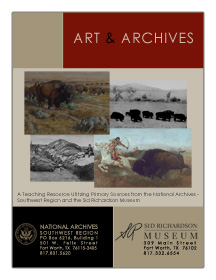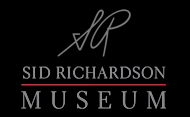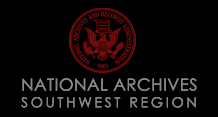
Home
About Art & Archives
About Sid Richardson Museum
About the National Archives
Primary & Secondary Sources
Lesson Plans
Contact Us
Reference Websites
Bibliography

Click the cover image above to view and download the complete 2006 ART & ARCHIVES Lesson Packet
Archive Vocabulary
Archives – a place in which public records or historical documents are preserved, also: materials preserved because of the enduring value they contain; permanent records.
Archivist – the professional staff member within an archival institution responsible for selecting, preserving, and providing access to records of enduring value.
Census – a periodic count of a population that may also capture information about specific qualities of the members, such as age, gender, ethnicity, occupation, and living conditions.
Conservation – a careful preservation and protection of cultural property for the future through examination, documentation, treatment, and preventive care.
Document – recorded information regardless of form with three basic elements: base, impression, and message.
Document box – a container that holds folders containing paper documents vertically and that measures roughly 10 inches high, 12 or 15 inches wide, and 6 or 3 inches deep, and that usually has an integral top hinged at the upper back. Sometimes called a Hollinger Box, document boxes are lined on the inside with acid-neutral paper and made from high-quality materials suitable for long-term storage of archival materials.
Federal Records – all papers, books, maps, photographs, machine-readable materials, or other documentary materials, made or received by an agency of the United States Government under Federal law.
Finding Aid – a description that provides information about the contents and nature of documentary materials.
Holdings – all documentary materials in an archival institution.
Microfilm – transparent film containing documents that have been photographed at a greatly reduced size.
Paleography – the study and analysis of handwritten documents.
Primary source – material that contains firsthand accounts of events and that was created contemporaneous to those events or was later recalled by an eyewitness. Primary sources include letters, diaries, government records, oral histories, photographs, film, maps, and newspapers.
Provenance – information about the origins and ownership of an item or collection.
Record Group – a collection of records that share the same provenance and are of a convenient size for administration.
Records Center – a facility used for efficient storage of inactive records before those records are destroyed or transferred to an archives.
Secondary Source - accounts of the past created by people who are not first-hand witnesses of the event. Secondary sources are one step removed from the event being described and offer an analysis or a restatement of primary sources. Examples of secondary sources include: dictionaries, encyclopedias, textbooks, histories, commentaries and articles that interpret or review research works.
Textual Records – records with content that is principally written words. Textual records are distinguished from non-textual records, which include audio-visual, cartographic, and machine-readable records.
Art Vocabulary
Atmospheric perspective - a method of implying depth and distance in a painting by using fading colors and hazy details in distant objects.
Background - the parts of an artwork which appear to be farthest away from the viewer and lie behind objects in the foreground and middle ground.
Balance - the arrangement of elements in a work of art. There are three kinds of balance: symmetrical (formal), asymmetrical (informal), and radial (from the center).
Composition - the arrangement of elements of an artwork to make it an effective expression of the artist's ideas.
Contrast - the degree of difference between colors, shapes, and other elements in an artwork (i.e., light and dark, rough and smooth).
Culture - the behaviors, customs, ideas and skills of a group of people.
Foreground - the part of an artwork which appears to be closest to the viewer.
Gouache - an opaque paint that can be dissolved in water.
Medium - the material an artist uses, such as acrylic, oil, or watercolor. The plural of medium is media.
Narrative art - art that suggests or tells a story.
Naturalism - artwork in which objects are represented as they are observed, rather than in a stylized manner.
Perspective - method used (linear or atmospheric) to depict the illusion of depth on a two-dimensional surface.
Proportion - the relation of one object to another in size, quantity, or degree.
Sketch - a quick, simple drawing without much detail which captures the main features of an object or scene and may be used as a reference for later work.
Studio - an artist’s workplace.
Symbol - a visual image that stands for something else, especially a letter, figure or a sign that represents a real object or idea.
Viewpoint - the position or place from which an artist views his or her subject to be represented.

